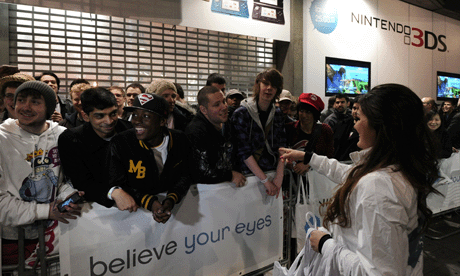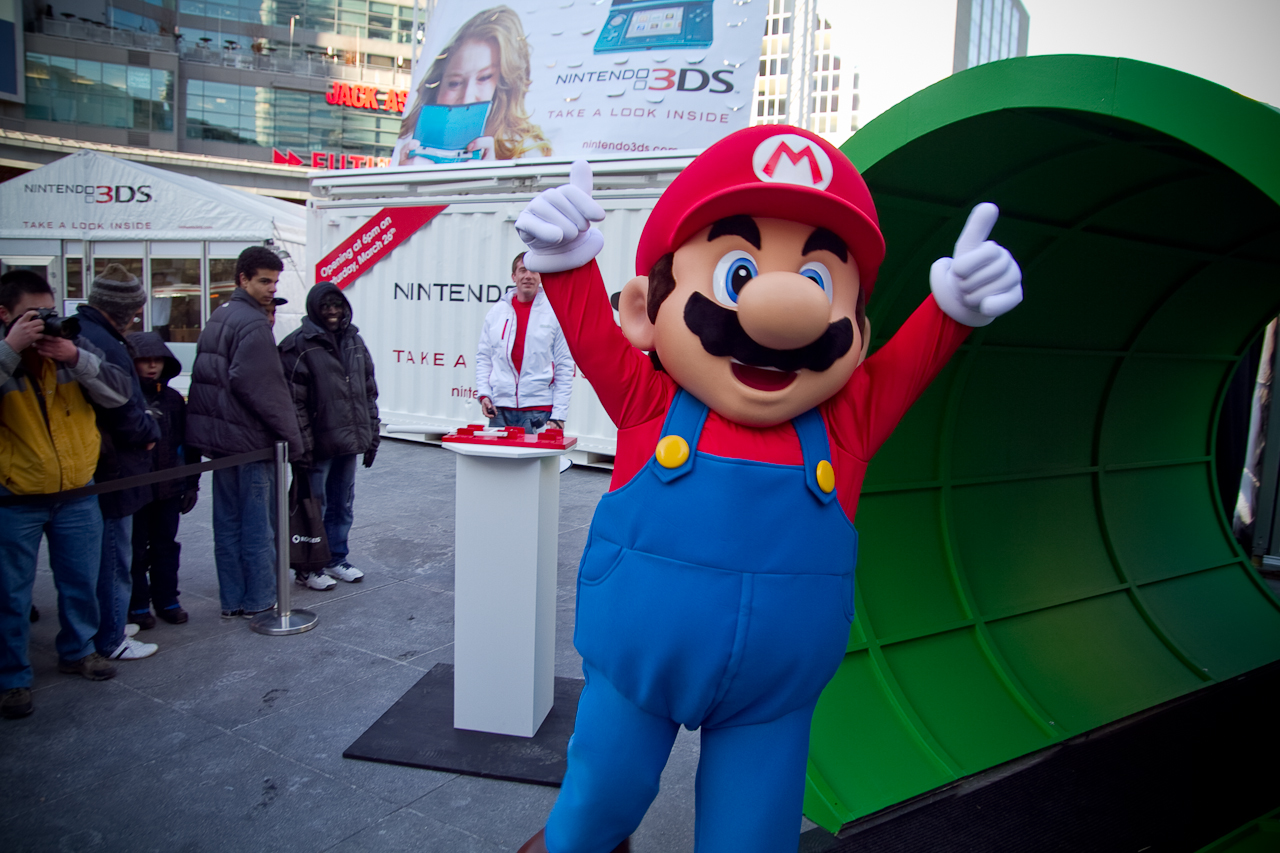Remember just a few months ago, when the 3DS was considered a flop? Remember when we had to wait weeks at a time for a new game, ANY new game to come out for the 3DS? Remember when Nintendo was forced to drop the price of the 3DS by almost a third worldwide mere months after its launch? Remember?
Who would have known that the handheld who struggled for so many months, who faced so much adversity, who could barely pump out two games per month, who had to suffer through so much pain... who would have known that this little 3DS would become the best-selling portable gaming console OF ALL TIME?
What exactly went right? How did the 3DS go from failure to overwhelming success? Upon its first anniversary here in North America, I thought that now would be the best time to go back in time and answer these questions.

Remembering the 3DS launch...
Remember the 27th of March. Remember Nintendo's launch party for the 3DS at the heart of New York City. The atmosphere, the noises, the sounds... and the presence of a brand new Nintendo handheld.
Now, a lot of people today will see the launch as a terrible flop, but in fact, the 3DS launch was actually a pretty big success. The system launched with 16 titles (18, if you consider all 3 versions of Nintendogs) and broke launch records in Japan, US, UK, and Australia. The American launch itself was the best launch in Nintendo handheld history.
No, it was not the launch that was disappointing. Like Sony's PlayStation Vita, it was what came after the launch that was disappointing. Shortly after launch on March 31, Nintendo announced that they had sold 3.6 million 3DS units, short of the 4 million they were expecting. And things just got worse and worse. Sales dropped drastically worldwide, even before E3 that year. Even Reggie admitted that sales had slowed, though he did expect the 3DS to pick up shortly after that with the launch of Zelda.
Boy was he wrong.
Why did sales drop so drastically? Well, for starters, it lacked software, or to be specific, good software. We were getting one new game every couple of weeks, and the release schedule was littered with 3D remakes of older games and ports.
The 3DS was also missing many features. The 3DS' internet browser and the Nintendo eShop didn't come until June. There was no messaging app, no solid online system, and seemingly no support from either Nintendo or third-parties. The 3DS was a paperweight. A very, VERY expensive paperweight.
And that leads me to my next point: price. The 3DS was way overpriced. At $250, it was more than an iPod Touch, a product that was undoubtedly at its high point at the time. But at $250, you could also get Sony's newest Playstation Vita, which had a sleek design and a beautiful OLED screen. It is no wonder that Nintendo decided to drop the price by almost a third in August.
And that was when Nintendo began doing things right.

Mario makes sales go up!
Several key events transpired during the last quarter of 2011 that spurred 3DS sales. Since Nintendo could no longer depend on third-parties to sell their hardware, Nintendo came to the software front directly, spewing out 5 retail titles in the period of 4 months: Star Fox 64 3D, Pokemon Rumble Blast, Tetris: Axis, Super Mario 3D Land, and Mario Kart 7. Of those titles, Super Mario 3D Land proved that 3D could be useful in games, and Mario Kart 7 proved that Nintendo had a working online system for games. These games, along with the 3DS' low price, made Nintendo's handheld look a lot more attractive than it used to.
But that's not all when it came to the retail front. The release of yet another game, this time Capcom's Monster Hunter 3G, caused the 3DS market in Japan to explode during the holiday season.
Even on the digital side, things began picking up. Though the launch of the eShop met with... well.... slow support, things started picking up. By providing free games and applications like Pokedex 3D, 3D Classics: Excitebike, and The Legend of Zelda: Four Swords Anniversary Edition, Nintendo made sure that the Nintendo eShop was made known to all 3DS users. With the exposure they needed, Nintendo quickly (okay, perhaps quickly isn't the best word to use) followed up with their 3D Classics series along with Freakyforms in November before the huge avalanche of content in December that consisted of the critically acclaimed Pushmo, the action puzzle platformer Mighty Switch Force, and the classic PC indie game VVVVVV.
And its not just games that boosted 3DS sales. Video content streamed from Netflix and the Nintendo Video Application made the 3DS much more than just a handheld gaming system; it had become a portable entertainment hub. Updates to built-in applications like the 3DS Camera and Mii Plaza (which included the long-awaited Find Mii 2) proved that Nintendo truly cared about the desires of their current fanbase by providing more content. Possibly the most critical application was Swapnote, a messaging application that was put into the Nintendo blender that resulted in a experience you can only find on a Nintendo platform; it was so good that Nintendo World Report called it the 3DS' "killer app."
Frankly, by the end of 2011, the 3DS was on a roll. And content just kept coming in. Retail games like Resident Evil: Revelations, Metal Gear Solid 3D: Snake Eater, and Kid Icarus: Uprising, among others, along with digital releases like Mutant Mudds and Dillon's Rolling Western gave 3DS owners the feeling that they had never felt before.
There were too many things to play on the 3DS.
Play this song while reading the concluding paragraph. There's nothing better than some good old Mario Kart 64 Victory Lap music to end the 3DS' first birthday. How fitting!
By its first birthday, the 3DS will have already sold around 16.6 million units worldwide, according to VGChartz, surpassing what both Nintendo and analysts were expecting. It's hard to imagine that just 6 months ago, the system was just inching over 5 million units. It's hard to imagine that just 6 months ago, we were still waiting for the 3DS' killer app. It's hard to imagine that just 6 months ago, we still had no Mario, no Pushmo, no Swapnote, and seemingly no support. We thought we were let down my Nintendo. We thought Nintendo was doomed. Yet now the 3DS has become the fastest selling video game console of all time, surpassing both the Wii (sold 14.6 million in its first year) and its predecessor the DS (sold 8.9 million in its first year). The little handheld that could has proved nay-sayers wrong. It proved that dedicated handhelds still had a place in the market. It proved that Nintendo still had what it takes to make great hardware. It surpassed all expectations. And better yet? There's still more to come. From Rayman to Roller Coaster Tycoon to Luigi's Mansion to Mario Tennis and beyond, games are still coming in left and right. It's a console that will forever be dear to our hearts. Here's to another great year on another great Nintendo handheld.
Happy birthday, 3DS!
What do you guys think about the 3DS' first year? (Oh, and enjoy the music! I love it <3)
![Amazing Spider-Man Finale Features New [SPOILER] Costume](../../../../../../assets1.ignimgs.com/2018/06/01/untitled-br-1527892808294_small.jpg)